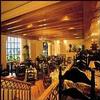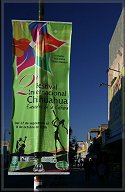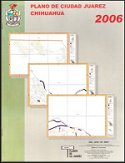Juarez, Mexico History
Despite it distance from Mexico City, Ciudad Juárez has played a significant role in Mexican history on at least two occassions. Did you know, for instance, that the final battle of the Mexican Revolution was fought in Juarez, Mexico in 1911? In 1862 French invaded Mexico and by 1863 had forced the Mexican president, Benito Juárez, to flee all the way to the border and conduct the war from Paseo del Norte (now Juarez). The city is named after this famous Mexican leader.
Downtown Historic Walking Tour
Despite it distance from Mexico City, Ciudad Juárez has played a significant role in Mexican history on at least two occassions. Did you know, for instance, that the final battle of the Mexican Revolution was fought in Juarez, Mexico in 1911? In 1862 French invaded Mexico and by 1863 had forced the Mexican president, Benito Juárez, to flee all the way to the border and conduct the war from Paseo del Norte (now Juarez). The city is named after this famous Mexican leader.
Martino Restaurant
Avenida Juarez Norte #643. This famous restaurant was built in the 1920s and due to its tradition remains popular with locals and visitors alike. Some years ago, the owners tried to close it. However, the employees united and bought the restaurant and presently operate it themselves. It is an outstanding example of Juarez’s culinary arts and features a variety of international cousines.
Club Kentucky
Avenida Juarez Norte #629. Welcome to the oldest bar in the city still in service. Since opening its doors in 1920, this bar with its great tradition has preserved its elegance and prestige. Great personalities from the world of politics, art, cinema, sports and bullfighting, including John Wayne, Steve McQueen, Elizabeth Taylor, Richard Burton, and Jack Dempsey, have all sat at its beautiful bar. The photographs of many other famous patrons are displayed on the walls. Here you can buy bullfight tickets during the season.
Baptist Temple
Avenida Juarez Norte #225. Built in 1921 this was the second Protestant Church established in Juarez. Building the church here was a very daring act during the days of U.S. Prohibition. From this location church goers witnessed the liquor and entertainment business boom. Religious services are still held here.
Club San Luis
Avenida Juarez and Avenida 16 de Septiembre. On this corner we find a brick building built to house the money exchange and bar known as Club San Luis. It was named after the Spirit of St. Louis, the plane flown by Charles Lindbergh on his famous transatlantic flight. A small replica of the plane can be seen on the front of the building. In 1929, Charles Lindbergh visited Juarez and met with Mexican aviator Capitan Emilio Carranza, famous for his record setting flights and greatly admired by the public along the border.
Casa Sauer Building
Avenida Juarez and Avenida 16 de Septiembre. Across from the museum is a building constructed in the 1920’s and named after George D. Sauer, a merchant dealing in groceries, wines, liquors, cigarettes, and import-exports. Sauer & Company existed at this site until 1934 and dealt in the beer and bottled drinks business in both Juarez and El Paso. In later years, this building housed the El Paso Trolley Company, Juarez Traction Co., El Paso Electric Co., and Southwest Telephone & Telegraph, all of which provided their services in Juarez. Medical offices, law firms, and public notaries continue to occupy the building.
History Museum
Avenida 16 de Septiembre #209. Built in 1885-89 this building served as the Customs House for many years and it now houses the city’s Historical Museum. It is one of the few examples of Victorian architecture left in Juarez and is characteristic of the Porfirio Diaz era (1876-1911). On October 16, 1909, Presidente Porfirio Diaz hosted a banquet for President William H. Taft in the central hall. This was the first meeting between presidents of the United States and Mexico.
The building’s rooms and halls were lavishly decorated for the festivities of Mexico’s Independence Centenial in 1910. Only one year and a few months later on May 8, 1911, the pact for Porfirio Diaz’s resignation of the presidency of Mexico was reached here. After the great battle of Ciudad Juarez in May, 1911, the peace treaties giving victory to the Mexican Revolution, headed by Franciso I. Madero, were signed in this building. The legendary Pancho Villa, Pascual Orozco and many other heroic figures participated in the “siege” of the city. The Mexican Revolution lasted ten years and numerous interested American took an active part in the events.
Since the arrival of the railroad in the 1880’s, all the merchandise that crossed from one country to another and payment of taxes were controlled in the Customs House. For many years the railroad was the primary choice for transporting cargo. Mexican trains still cross the center of town at night to link up with the Union Pacific, Burlington Northern/Sante Fe railways in El Paso.
In 1990, the entire building was restored so that it could open its doors as the Ciudad Juarez Museum of History. This museum has a permanent exhibit of regional history starting with pre-Columbian cultures such as that which existed in the Casas Grandes and Paquime in the state of Chihuahua. It also covers the explorations by the Spanish Conquistadors, the period of the Spanish Vice-Royalty, Independence, the Reformation, and the Porfirio Diaz era. Finally, two halls are dedicated to the Mexican Revolution.
Site of Benito Juárez's Office
Avenida 16 de Septiembre Poniente (west). From 1865 to 1866, Mexican president and patriot Benito Juarez was forced to move from one place to another while fleeing the occupying French forces who were trying to install Maximilian of Habsberg as Emperor of Mexico. Juarez wound up in Paso del Norte and at this location he maintained his office. Later he returned to Mexico City to occupy the National Palace upon the defeat of the French troops and fall of the Empire.
The Juarenses of that era were rewarding for the services they performed for the nation, and the city subsequently took the name of this Mexican hero. The city’s coat of arms bears the motto “Custodian of the Republic.”
A small bust and plaque commemorate the site of his office that served as the seat of government in that troubled time. At this site also stood the post office building, which was destroyed during the Mexican Revolution in the fierce battle of Juarez on May 8, 1911. Many buildings were badly damaged and destroyed during the Mexican Revolution and with them their silent testimony to the history of the city.
Old City Hall
Calle Mariscal at Avenida 16 de Septiembre. Old City Hall dates back to the late nineteenth century. Saw cut lava rock covers the thick adobe walls and beams which still guard the interior. This building was a “predisio” (fort) that served as barracks for the troops who fought the ferocious Apache Indians and protected travelers on the El Camino Real.
During the eighteenth and nineteenth centuries peace treaties with the Indians were signed in this building. The highest authority was the Captain of the Presidio, who was a lieutenant of the Governor of New Mexico. Paso del Norte was the village with the greatest inhabitants in the province.
It was in this building that the first town council of El Paso del Norte met and decided to join the state of Chihuahua and cease being a part of New Mexico. The American flag flew over the building in 1846-47 when Col. Alexander Doniphan’s army occupied the village during the Mexcan-American War. In 1947 it was reconstructed. In the foyer is a mural depicting the local history and on the façade of the building the Juarez Coat of Arms. This site was the seat of civil authority for over 300 years.
Mission de Guadalupe
Calle Vicente Guerrero in front of the Plaza de Armas. Standing in front of the Mission is a statue of its founder, Fray Garcia de San Francisco. Born in Old Castilla, Spain, he came to the new World in 1629 and established the Mission of Our Lady of Guadalupe (1659) among the Manso Indians at the Pass of the North, a strategic location along the developing El Camino Real.
The bronze sculpture in front of the mission is a small replica of the one located in downtown El Paso. It depicts Fray Garcia in the act of building his mission. In his right hand he holds the lintel bean carved by the Manso Indians and bearing the name of the mission and year of its founding At his feet is a cluster of grapes in a Manso basket, which represents the viticulture and agriculture which he introduced into the area.
In December 8, 1659, Fray Garcia de San Francisco, accompanied by Fray Juan de Salazar and ten families of Christian Indians, built a provisional oratory out of branches and mud and a monastery with a roof of straw. On January 5, 1662, the New Church of the Mission of Our Lady of Guadalupe was inaugurated. One hundred natives were baptized that day.
Fray Garcia, after 12 years at the Pass, returned to minister among the Piro Indians of Senecu Mission, near modern Socorro, New Mexico, until his death on January 22, 1673.
Guadalupe Mission is the mother of the El Paso Valley Missions. To the tired traveler along the Camino Real, it was an important stop for food and rest. During the 1680 Pueblo Revolt in New Mexico, over 2500 Spanish refugees and displaced Indians received food and shelter at the mission. Until 1692, the pass of the North was the most northern outpost in in colonial Spain in the New World.
Constructed solely of adobe, the thickness of its walls can be appreciated at the main and side doors. These doors with their simple portico and Spanish colonial oval windows known as “Ojo de Buey” (Bull’s Eye), have been recently restored following the original sketches. The ceiling stands out for its artistic quality. The missionaries came from the Iberian Peninsula where an Arabic influence can be seen in civil and religious buildings. At the Mission of Guadalupe, one can appreciate the Indian elements in the rectangular decorations, the braiding, the circular stairs, the toothed profiles and the serpent pallets carved into each one of the ceiling rafters, sacristy doors, candlesticks, lectern, and the side chapel.
At the center, the church has a stone altar installed during the last restoration (1968-71). Under this altar lie the remains of the first settlers. The floor is flagstone. The choir, at the back of the church, is made of wood and is supported by two elegant carved wood columns crowned by a wide capital. The entrance door to the choir is sealed for its protection but one can admire the work on the door since it is one of the original doors of the mission. At the head of the altar is a panel with the image of the Virgin of Guadalupe in a finely carved wood and glass niche. The entire building is seventeenth century Mexican Baroque which includes the Indian motifs.
Cathedral
Avenida 16 de Septiembre in front of the Plaza de Armas. The Cathedral was also dedicated to the Virgin of Guadalupe, patron of the cities, and and has been seat of the Bishop of the Diocese since 1957. Begun in 1941-45, it was rebuilt between 1975 and 1977 after it was destroyed by fire. The original façade and 100 ft. towers remain. The rest of the building was completely transformed in an austere and sober style. On the south side is the stained glass window representing “The Grace of God in the salvation of Mexico through the Virgin of Guadalupe”, as well as the miracle of the roses.
Benito Juárez Monument
Calles Vicente Guerrero, Ramon Corona at Constitucion. This is the most important monument within the city. It is an architectural gem commissioned by Governor Enrique Creel for the Centennial celebrations of Mexico’s Independence. In 1909, President Porfirio Diaz came to Ciudad Juarez to place the first stone of this monument. It was finished one year later and inaugurated on September 16, 1910. Italian sculptors Augusto Volpi and Fransisci Rigalt were the overseers of the project. The monument is constructed of marble and has four plaques which represent the most significant episodes in the presidency of Benito Juarez.




